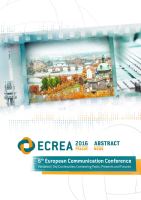

194
Saturday, November 12
1 6 : 0 0 – 1 7 : 3 0
PP 726
The Engagement of African Diaspora Audiences with African Film Festivals in Brussels
L. Nsengiyumva
1
, J. Bauwens
1
1
Free University of Brussels Vrije Universiteit Brussel, CEMESO Media and Communication Studies, Brussels, Belgium
After decades of western cinema and filmmaking implicated in ‘othering’ African people and their culture, producing racist stereotypes and symbolically
violent images of African life and dehumanizing the gaze of African people, the early 1960s saw the coming of African filmmakers who understood cinema
as a critical medium for cultural citizenship and empowerment (Dovey, 2009). As a result, from the mid-1960s the first African film festivals emerged with
Journées cinématographiques de Carthage and Festival Panafricain du Cinéma de Ouagadougou. The rise of these two film festivals soon caught the atten‑
tion of renowned European film festivals like Cannes and Berlin. From there on, African film festivals started flourishing throughout European cities (e.g.
Africa in the Picture, Amsterdam) (Dovey, 2015). African film festivals in Europe were established not only to create a space where African filmmakers could
network with global film industry professionals, but also to contribute to community-building, cultural democracy, empowerment and participation – aka
cultural citizenship (cf. Hermes, 2005). By providing the forum for lively interplay between filmmakers, curators, scholars, political activists and audiences
to gather and share experiences, the festivals met the need for spaces where not only European, but also African diaspora communities could engage with
African films, which were (and still are) massively absent in the offer of mainstream media outlets. However, notwithstanding the proliferation of African
film festivals all across Europe, African diaspora audiences are remarkably unfamiliar with these happenings. African film festivals outside Africa seem to fail
in fulfilling their promises to African film-makers and African audiences (Diawara, 1994). Why is there a low attendance of the African diaspora audience at
these festivals? Which cultural, social and economic barriers help us understand why African people living in Europe do not feel part of these events? And
how are the African film festivals in Europe dealing with this deficit?These research questions are dealt with in a multiple case study of three Belgian African
film festivals: Afrika Film Festival, Massimadi Film Festival, and the Festival International du Film Africain de Belgique. Building on (1) interviews with
the festival organizers, filmmakers, distributors, audiences and African cultural institutions, and (2) observations of the organization and actual proceeding
of the festivals, we explore the dynamics of in/exclusion in the way the festivals are conceived, promoted and experienced. Belgium is hereby an interesting
country-case because of its large African diaspora population, most notably the three former Belgian colonies (Congo, Rwanda and Burundi) as well as
Morocco, Cameroon, Senegal and Cote d’Ivoire. Nevertheless, African people still find it difficult to gain their foothold, both socially and economically, in
a society that has never dealt and consequently never moved on from its colonial past. References Diawara, M. (1994). ‘On Tracking World Cinema: African
Cinema at Film Festivals’, Public Culture, 6(2): 385–396. Dovey, L. (2009). African Film and Literature: Adapting Violence to the Screen. New York: Columbia
University Press. Dovey, L. (2015). Curating Africa in the Age of Film Festivals. NewYork: Palgrave Macmillan. Hermes J. (2005). Re-reading popular culture.
Malden: Blackwell Publishing.
PP 727
Identity Performances on Social Media in Everyday Life: Mundane Expressions of Nationalism and Cosmopolitanism Among Serbian
Londoners
S. Vico
1
1
Goldsmiths- University of London, Media and Communications, London, United Kingdom
This study explores how Serbian Londoners navigate the digital media environments and negotiate their identities on different platforms, in order to make
an argument about whether different media invite different identities and in what ways. It also aims to examine whether there are cultural differences in
how these participants appropriate different platforms. In particular, I look at mundane expressions of nationalism and cosmopolitanism among Serbian
Londoners, in order to understand broader political and social implications of their everyday communication practices. Some recent studies have showed
that the affordances of digital media are not neutral: they may shape users’ interactions and thereby may enable certain dynamics (see, Baym 2010, boyd
2010). Therefore, I draw on Madianou and Miller’s (2012) concept of polymedia in order to understand how people perform their identities in digital media
environments in their everyday life and what role the affordances may have in this. On the other hand, Miller (2010) argues that Facebook does not have
meanings outside the way people appropriate it. This also opens up room to examine whether any of these platforms have been “Serbianised”, in the way
as Facebook is being“Trinidadianised,”according to Miller (2010), and if so, how. Further, this study looks at the role of ambient co-presence and mediated
interpersonal communication in shaping a sense of belonging. I also follow Hall’s (1990) understanding of identity as contextual and always in process.
In line with this, this research takes a bottom-up approach to studying cosmopolitanisms and nationalism as identities that are lived and performed in
everyday life, constituted of a set of practices and dispositions. It draws upon the concepts of banal nationalism (Billig, 1995) and ordinary cosmopolitanism
(Woodward and Skribis, 2010). The aim is to understand the role of the quotidian manifestations of nationalism in polymedia environment, embedded in
ordinary words and images, in a sense of belonging among this group, as well as how they negotiate their cosmopolitan identity in relation to a particular
context. Therefore, this study tries to examine if the normative element of cosmopolitanism can indeed be eliminated and invites the readers to rethink
these concepts.To this end, I have been conducting ethnography, including online ethnography, in-depth interviews and visual analysis since summer 2015.
The conclusions will be drawn from ethnographic fieldwork and interviews conducted with about fifty participants, an equal number of men and women,
all of whom are adults and have lived in London for at least two years before being interviewed. Data will be analysed in relation to three generations that
have been identified, as they tend to show different characteristics, patterns in behaviour and communication practices. The first generation constitutes
people who arrived in the UK before the 1990s and are UK-born, the second refers to those who came in the 1990s and shortly after, and the third generation
is consisted of people who arrived after 2005. Key words: social media, polymedia, identities, Serbian Londoners, banal nationalism, banal cosmopolitan‑
ism, affordances



















